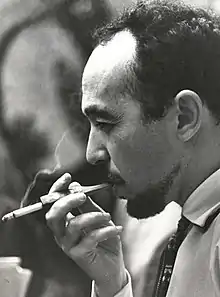Togrul Narimanbekov
Togrul Farman oglu Narimanbekov (Azerbaijani: Toğrul Fərman oğlu Nərimanbəyov, Russian: Тогрул Нариманбеков; 7 August 1930 – 2 June 2013) [1] was one of the prominent modern Azerbaijani artists.[2][3]
Toğrul Nərimanbəyov | |
|---|---|
 | |
| Born | Toğrul Fərman oğlu Nərimanbəyov 7 August 1930 |
| Died | 2 June 2013 (aged 82) |
| Nationality | |
| Known for | Artist, Opera singer |
| Awards | People's Artist of Azerbaijan (1967), USSR State Prize (1980), Order of Sovereignty (2000), Order of Glory (2010) |
History
Narimbanbekov was born in Baku. His father, Farman Narimanbekov, who hailed from Shusha,[4] studied in Toulouse; in 1929 he came back to Baku and participated in the construction of Mingachevir Hydro Power Plant, but in the 1930s was sentenced to imprisonment. His wife Irma Laroudé, a Frenchwoman, was exiled to Uzbekistan and stayed there till 1961.
Toghrul Narimanbekov studied at Azerbaijan Art School named after Azim Azimzade, then, from 1950 to 1955, at Lithuania Institute of Fine Arts.
He was the laureate of the USSR State Prize (1980) and People's Artist of Azerbaijan (1967). He lived in Paris and had a French citizenship until his death.
He assumed that, it is necessary for arts to return to origins of national culture. He described his creativity as a combination of abstract and figurative arts.[5]
Asmar Narimanbekova, his daughter from the first marriage to Elmira Hüseynova,[6] is an Honoured Artist of Azerbaijan and associate professor of Azerbaijan State Academy of Fine Arts.[7]
François Narimanbekov is his son, born on 24 May 2001 of his second marriage with Sevil Narimanbekova. Besides artistic activity, Narimanbekov had excellent voice and he performed various arias of Azerbaijani and foreign composers in his youth. In August 2010, he was awarded the Order of the Badge of Honour of Azerbaijan.[8] He died, aged 82, in Paris.
He is brother of Vidadi Narimanbekov, a member of Narimanbekov family.
References
- BBC Azeri Service News ( http://www.bbc.co.uk/azeri/azerbaijan/2013/06/130608_narimanbekov_died.shtml )
- Bown, Matthew Cullerne; Taylor, Brandon (1993). Art of the Soviets: painting, sculpture, and architecture in a one-party state, 1917-1992. Manchester University Press ND. pp. 152–. ISBN 978-0-7190-3735-1. Retrieved 28 April 2011.
The 'decorativism' denounced in the late 1940s broke out again all over the place, exemplified in the work of the Azeri painter, Togrul Narimanbekov.
- "Тогрул Нариманбеков: "Я поеду в Шушу не как гость, а как хозяин" - ИНТЕРВЬЮ-ФОТОСЕССИЯ". APA.az. Archived from the original on 2012-06-13.
- [Zərif Çərşənbə https://www.youtube.com/watch?v=Yj5R6MoGiqg]. ANS. 26 January 2010. Television.
- "Работы художника Тогрула Нариманбекова". Archived from the original on 2012-04-20.
- "İncə Sənət: Bir heykəltəraş barədə..." [Fine Art: On a sculptor ...] (in Azerbaijani). Baku, Azerbaijan: Yeni Avaz. 13 February 2017. Archived from the original on 11 April 2017. Retrieved 12 April 2017.
- "Большая трагедия знать, что нас сменит необразованное поколение – Эсмер Нариманбекова". azeri.ru.
- "Тогрул Нариманбеков награжден орденом "Шараф"". day.az.
External links